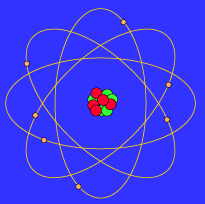Metabolism
Metabolism is a general term used to refer to all of the chemical reactions which occur in a living system. Metabolism can be divided into two parts; anabolism, or reactions involving the synthesis of compounds; and catabolism, or reactions involving the breakdown of compounds. In terms of oxidation-reduction principles, anabolic reactions are primarily characterized by reduction reactions, such as the dark reaction in photosynthesis where carbon dioxide is reduced to form glucose. Catabolic reactions are primarily oxidation reactions. Although catabolism involves many separate reactions, an example of such as process can be described by the oxidation of glucose as shown below. Note that this equation is the reverse of the photosynthetic equation.
C6H12O6 + 6 O2 ----------> 6 CO2 + 6 H2O + Energy
Note also, that in this reaction, the carbon atoms in glucose are oxidized, undergoing an increase in oxidation state (each carbon loses 2 electrons) as they are converted to carbon dioxide. At the same time, each oxygen atom is reduced by gaining 2 electrons when it is converted to water. Part of the energy is released as heat and the remainder is stored in the chemical bonds of "energetic" compounds such as adenosine triphosphate (ATP) and nicotinamide adenine dinucleotide (NADH).
Catabolic reactions can be divided into many different groups of reactions called, catabolic pathways. In these pathways (referred to as Glycolysis, the Citric Acid Cycle, and Electron Transport) the carbon atoms are slowly oxidized by a series of reactions which gradually modify the carbon skeleton of the compound as well as the oxidation state of carbon. Coupled to these reactions are other reversible oxidation-reduction reactions designed to capture the energy released and temporarily store it within the chemical bonds of compounds called adenosine triphosphate (ATP) and nicotamide dinucleotide (NADH) . These compounds are then utilized to provide energy for driving the cellular machinery.
skip to main |
skip to sidebar


Bhor's atom model
Oxidation reduction reaction.
Search

Custom Search
How is this blog?
Blog Archive
-
▼
2009
(24)
-
▼
August
(24)
- Oxidation Reduction
- Oxidation states
- Definition of oxidation reduction
- Ionic compound
- Ionic formulas
- Electronegativity
- Electronegativity & Metal/Nonmetal CompoundsAs ind...
- Redox Reactions Involving Nonmetals OnlyThe situat...
- Guidelines - Oxidation States of Nonmetals1. When ...
- Types of redox reaction.
- Combination reactions
- Decomposition reactions
- Single displacement reactions
- Balancing Redox Reactions Using the Half Reaction ...
- Balancing Redox Reactions in Basic Solutions
- Bleaching Agents (Application of redox reaction)
- Photosynthesis (Application of redox reaction)
- Metabolism (Application of redox reaction)
- Nitrogen Fixation(Application of redox reaction)
- Combustion of Fuels (Application of redox reaction)
- The "Dry-Cell" Battery
- Electrochemical Cells (Application of redox reaction)
- Photo-oxidation - Photochromic Glass (Application ...
- Corrosion (Application of redox reaction)
-
▼
August
(24)
Labels
- . single displacement reactions (1)
- balancing redox reactions in basic solutions (1)
- balancing redox reactions using the half reaction method (1)
- bleaching agents (1)
- combination reaction (1)
- combustion of fuels (1)
- corrosion (1)
- decomposition reactions (1)
- definition of oxidation reduction (1)
- electrochemical cells (1)
- electronegativity (2)
- ionic compound (1)
- ionic formula (1)
- metabolism (1)
- nitrogen fixation (1)
- oxidation number (2)
- oxidation reduction (1)
- Photo-oxidation - Photochromic Glass (1)
- photosynthesis (1)
- redox reactions (1)
- the "Dry-Cell" battery (1)
- Types of redox reaction (1)
Image

Bhor's atom model

No comments:
Post a Comment